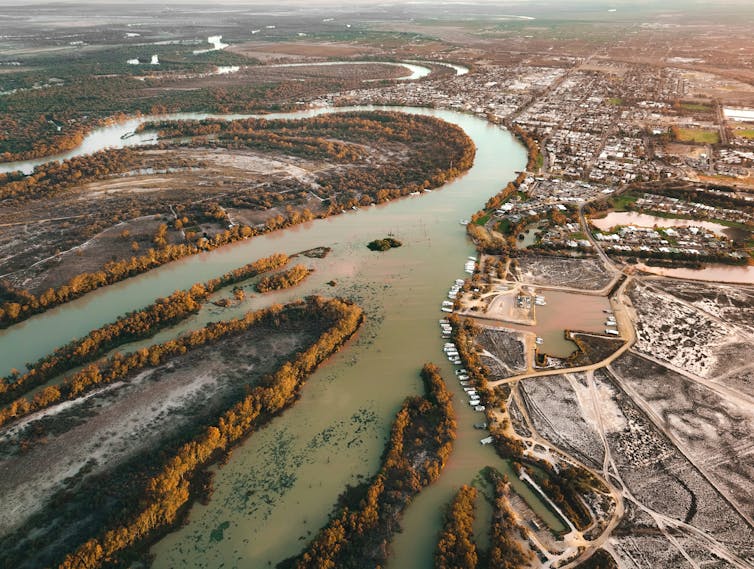Accounting for climate change is in its infancy – and a UNSW academic says getting it right requires new ways of thinking.
In January this year, mandatory climate reporting requirements affecting more than 6000 Australian organisations came into effect. The laws aim to provide investors with clarity about the impact of climate change on organisations, and to incentivise investment in mitigating the risks, including the need to rapidly work towards a zero-carbon economy while also adapting to the increasing severity and frequency of climate extremes.
UNSW’s Dr Tanya Fiedler, an internationally recognised pioneering expert in the field of climate risk accounting and accountability, says organisations are not set up to accurately calculate their exposure to risks from climate extremes using current approaches, and risk accusations of greenwashing and greenhushing if they do not do so with care.
Instead, Dr Fiedler is advocating an approach developed in the climate sciences that is explicit about the complexity and uncertainties involved in identifying these kinds of risks. This approach is known as ‘storylines’.
Why make climate-related financial disclosures?
Countries around the world are in the process of developing standards and regulatory mandates based on the Taskforce on Climate-related Financial Disclosures (TCFD).
The taskforce was convened by the Financial Stability Board, an international body that monitors and makes recommendations about the global financial system.
The purpose of the Financial Stability Board, which includes members from all G20 major economies and the European Commission, is to identify and consider ways in which to manage circumstances that might potentially cause the next global financial crisis. They identified climate change as a risk to global financial stability.
“The TCFD recommendations were pivotal in bringing about changes to the reporting landscape, because they drew a direct link between the risks of climate change and financial risk, arguing that climate-related risks should therefore flow through into financial reporting obligations in the same way that any other risks do,” says Dr Fiedler.
Two types of climate-related risk
Climate-related risks are divided into two categories. The first is the risk posed by the transition to a low or zero carbon economy (transition risk). For example, companies that rely on fossil fuels to operate can be considered vulnerable in the transition to a zero-carbon economy because their business model is unlikely to survive.
“Transition risks can be understood as an economic problem,” explains Dr Fiedler. “As nations move to zero-carbon economies, government policies, global markets, supply chains, technological advances and consumer preference will influence how businesses operate, including their decisions about which products or services they will produce. Because these changes are economic in nature, and can be conceptualised in economic terms, they are familiar to people in business.”
The second type of risk comes from the physical effects of climate change itself (physical risk), and takes into account things like the damage to housing and infrastructure through things like fire, flooding, storms and drought.
“Unlike transition risk, when analysing physical risk organisations rely on models and information sources developed in the climate sciences. These, in contrast to the economic models underpinning assessments of transition risk, are deeply unfamiliar to business,” says Dr Fiedler.
The problem of measuring physical climate risk
The problem with understanding physical risk is that you rely on climate model projections in some form.
“The models underpinning such projections, however, were largely built to provide information relevant for questions at global scales, not for questions of risk relevant at the scale of a business,” says Dr Fiedler.
“The models were built to provide information for global politics and policy negotiations – to inform the United Nations Framework Convention on Climate Change, and set targets under the Paris Agreement, etc. They can be incredibly complex, because you are trying to model the physics of the entire earth system but scaling them down to understand impacts at the level of an organisation is fraught with problems.”
In response to requirements to disclose climate risk, there has therefore been a proliferation of service providers keen to supply companies with summaries of their risk based on proprietary top-down models in what has been described as a “climate intelligence arms race”.
“In effect, we’re trying to build an entirely new system of accounting in a period of a decade, whereas financial and cost accounting have developed over centuries. So, what you have is this massive investment in climate intelligence by global service providers. To my knowledge, however, none of the models, algorithms, or methods they use have been peer-reviewed by scientists, and academic research is increasingly showing the outputs of such work to be problematic,” says Dr Fiedler.
The Storylines solution
In their paper ‘Storylines: A science-based method for assessing and measuring future physical climate-related financial risk’, Dr Fiedler and her co-authors summarise 10 key challenges that emerge for those trying to employ global climate models for the purpose of assessing physical risk at the scale of an organisation. This serves as the foundation for arguing for an alternative approach – that of storylines.
Physical climate storylines contrast with the top-down models people in accounting, economics and finance are accustomed to, by drawing on multiple lines of evidence and the opinions of multidisciplinary teams of experts. These then employ that evidence to build narratives that describe the causal networks through which changes in the extremes relevant for a specific group of assets, operations, supply chains or communities are driven.
But knowing which data sources to use (and when) requires high levels of expertise of a kind not available to everyone – as does establishing how information from climate models can inform these other forms of data in a way that is scientifically rigorous. Organisations therefore face a delicate balance between understanding climate risks, adhering to regulations, and communicating these risks. “It’s a complex dance of science, compliance, decision-making, strategy and disclosure that requires careful coordination.”
“Storylines allow organisations to understand the risks they face from climate change by acknowledging its complexity and uncertainties. Storylines also facilitate the communication of this complexity and uncertainty in narrative form,” says Dr Fiedler.
“Uncertainties associated with the risks arising from some types of climate extremes in particular can’t be presented confidently in quantitative form. So instead, a narrative is called for that allows decision making to proceed with an understanding of the full range of that uncertainty. This is important, as without appreciating the full range of potential outcomes, decisions can be made that might prove really damaging over the long term.”
For example, when assessing flood risk to a business entity, a storyline approach might mean looking at global climate model projections, but also at any recent changes to the catchment area such as new roads, as well as how the buildings in question are engineered, their resilience or thresholds of vulnerability, and how employees could be affected.
“Storyline-enhanced risk assessment can be conducted in practice and in a manner complementing traditional risk assessment processes,” says Dr Fiedler, who is currently working with several financial institutions to support them in understanding their vulnerability and exposure to physical climate risk.
“The storyline approach makes use of quantitative information wherever possible, but the output is narrative that integrates both qualitative and quantitative information. It has the opportunity for a more integrated way of understanding organisational vulnerabilities and exposures.”
Dr Fiedler is now aiming to work with organisations to understand how the storyline approach can be operationalised in different settings, “so that we can begin to develop consistency and comparability in how physical climate risk is understood by different industries across different physical environments”.
Dr Fiedler is a Scientia Fellow at the UNSW Institute for Climate Risk and Response and School of Accounting, Auditing and Taxation, UNSW Business School. Dr Fiedler’s collaborators on the Storyline approach are Dr Nick Wood (Climate Policy Research), Dr Michael Gross (CSIRO), and Prof. Andy Pitman (ARC Centre of Excellence for Climate Extremes).







